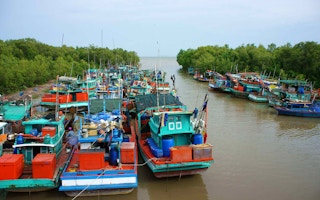The massive expansion of hydropower along the Mekong River is putting 18 per cent of the world’s freshwater fish supply at risk as well as food security in the Mekong region.
Dam development is threatening the region’s rich ecosystem and productivity, partly due to the significant reduction in sediments, according to a new book launched by the non-profit research group WorldFish and the Consortium of International Agricultural Research Centers (CGIAR).
From only 16 dams operating in 2000, the number of dams along the river is expected to increase between 77 and 136 by 2030. The impact of the dams may stretch as far as the South China Sea yet there has been a lack of regional planning.
“The Mekong River is unique in its fish abundance, density of fisheries and share of migratory fish,” says Eric Baran, a senior scientist at WorldFish and lead author of the book which aims to provide planning tools for the sustainable development of dams for countries located on the Mekong.
The Mekong River is the largest inland fishery in the world, with 2.1 million tonnes of fish harvested each year that are essential for food security in the region. It is the third richest river in the world in terms of fish biodiversity, featuring 781 fish species, including 165 migratory species. The river also has one of the world’s largest sediment loads.
“A number of other rivers in the world have been dammed but it didn’t have an impact on food security because people in those countries were not directly reliant on the river fish, which were not necessarily as migratory as they are in the Mekong. That’s why the Mekong is very special and very sensitive to damming,” Baran stresses.
“In terms of food security, we’re talking about 550,000 to 800,000 tonnes of migratory fish that are at risk every year,” he says. “That’s the equivalent of the annual production of freshwater fish in the whole of West Africa.”
Dam development is expected to result in a 60 to 96 per cent reduction in sediment load in downstream Mekong waters by 2030, according to the book. Dams act as obstacles to the free flow of water and can obstruct the flow of sediments and nutrients, affecting all living organisms in the river and the geomorphology of the river itself.
“When you lose the sediments, you lose the physical and chemical materials that are bound to the sand and mud. This impacts river productivity — and river productivity is not just fish, it’s everything,” notes Baran.
“These nutrients in the water feed the whole food chain, including vegetation, algae, rice fields and flood plains. That’s why we wanted to flag it because the impact goes far beyond what is usually recognised.”
One of the biggest issues with the dams is that “you basically alter the ecosystem and obstruct the seasonal dynamics of the Mekong”, adds Magnus Torell, senior advisor of the Southeast Asian Fisheries Development Center (SEAFDEC) Secretariat.
“The whole system builds upon the very large seasonal variation in water flow with the expanding flood plains.”
He adds that environmental impact assessments mostly just look at impacts close to the construction site and seldom study the cumulative effects of very many dams and reservoirs.
But as Baran notes, “One dam can be more damageable than several others. Some dams can produce a fair amount of electricity for a minimal damage. Others create a big damage for limited electricity production. They are not all equal. There needs to be planning about that, more intercountry communication and a regional process.”










